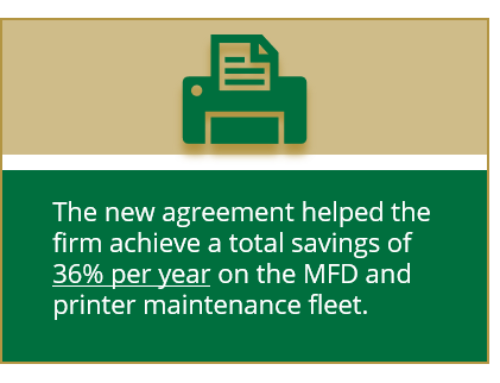 Walk up to any computer in your firm and press the print button. Then follow the printing sound down the hall to the printer. Stop, look down and contemplate the machine in front of you. If you’re like many firms, you’re probably looking at a source of excess cost that eats away at your bottom line one print at a time.
Walk up to any computer in your firm and press the print button. Then follow the printing sound down the hall to the printer. Stop, look down and contemplate the machine in front of you. If you’re like many firms, you’re probably looking at a source of excess cost that eats away at your bottom line one print at a time.
Chances are the printer is one of a long list of devices—black and white printers, color printers, scanners, copiers—that are deployed throughout the offices in your firm. And most likely, the unique mix of these devices across your technology landscape is the result of years of “organic growth”—adding new devices when needed, picking from the latest market offerings and not necessarily with regard to the rest of the existing devices.
Why is this important? As your firm grows and adds, replaces, upgrades, etc., you gradually introduce a wider-and-wider range of device manufacturers, maintenance plans, replacement part needs and more. This is a common storyline for firms that we work with—and an opportunity in waiting, to consolidate and save. By reducing the number of devices—consolidating printing/scanning/copying/faxing into a Multi-Functional Device (MFD)—reducing the number of different manufacturers, and improving the ratio of users-to-devices, your firm can achieve big savings in this must-have capacity.
Take a look at some of the key indicators to begin to know whether your firm is primed for cost savings and efficiency in this important area:
- Number of Devices – How many printers, copiers, scanners, fax machines are deployed throughout your offices
- Durability of Each Device – How often are you replacing black-and-white printers? Are you covered under contract for defects or replacement parts?
- Number of Functions Needed – Do people have a Multi-Function Device or high-cost color printer on their desk but only ever print in black and white?
- Number of Manufacturers (brands) – HP, Xerox, Ricoh, Canon, Brother, Epson, Minolta and Lexmark – does your list read like a who’s who in the market? Hint, too many means potential waste and an inability to leverage spend.
- Number of Maintenance Contracts – One for each manufacturer? Or each office?
- Number of Replacement Parts Consumed – How often and how many printer cartridges are you ordering? From what sources? What brands?
- Number of Device Users – How many people in your firm are actively using each of these devices
- Ratio of Users-to-Devices – If everyone has their own printer, you’re probably a prime candidate for improved efficiency!
- Percent Utilization of Each Device – Are some printers sitting idle next to a single user who only prints monthly reports?
- Cost Recovery Strategy – Has your firm’s cost recovery strategy kept up with the migration from a copy/fax workflow to the current print/scan model?
How do you know if your firm is a good candidate for reducing cost and improving efficiency? It’s not as easy as it first appears. An ideal strategy comes from considering not only the devices, but the contracts associated with each, and needs and roles for each device across your firm’s users. Start by talking to an industry expert (like Mattern) who can review your current situation, interpret the data and make informed recommendations on whether and how to respond with changes.
Click here to download a PDF copy of this article.


